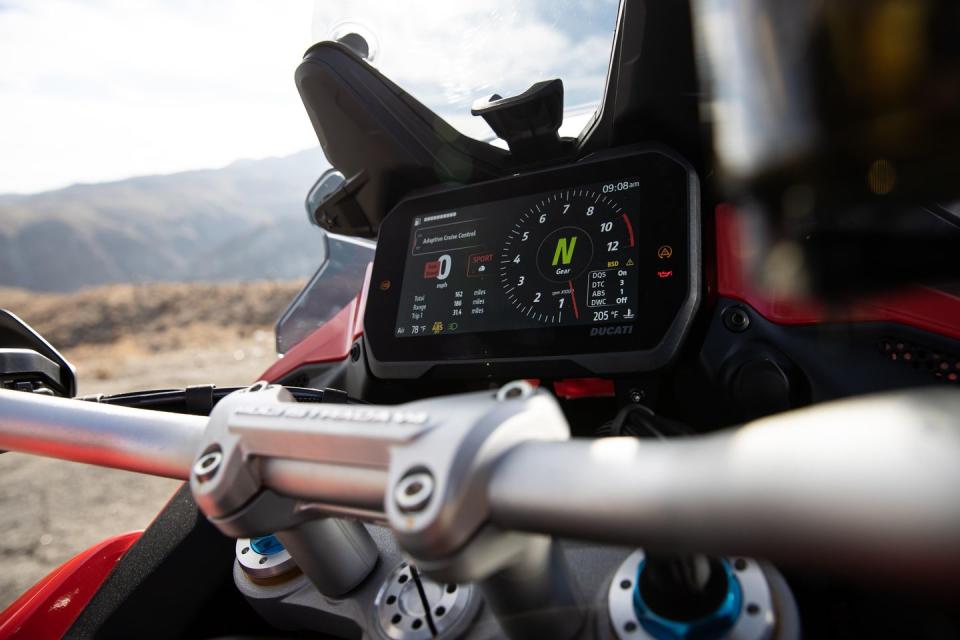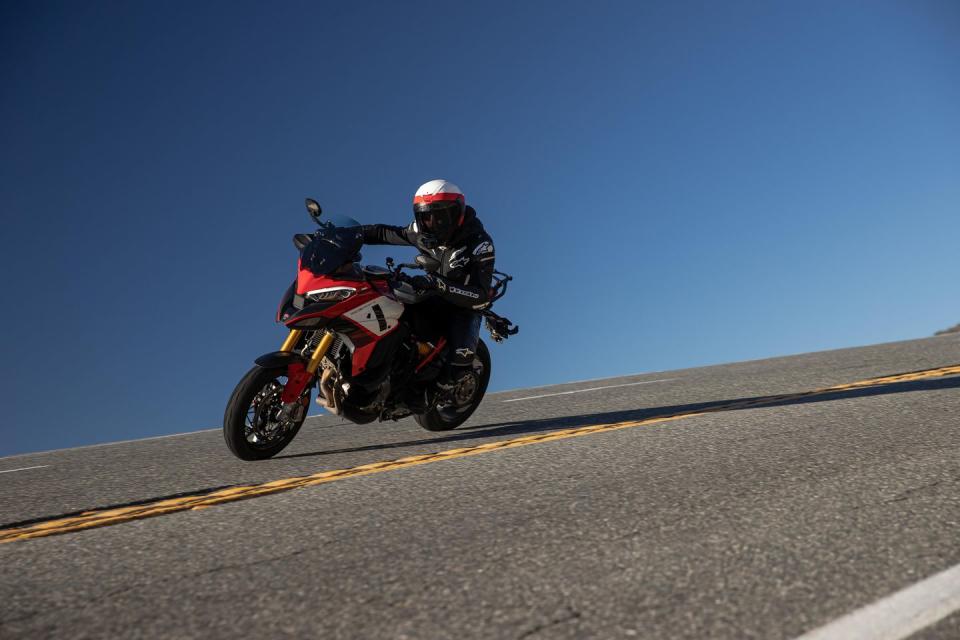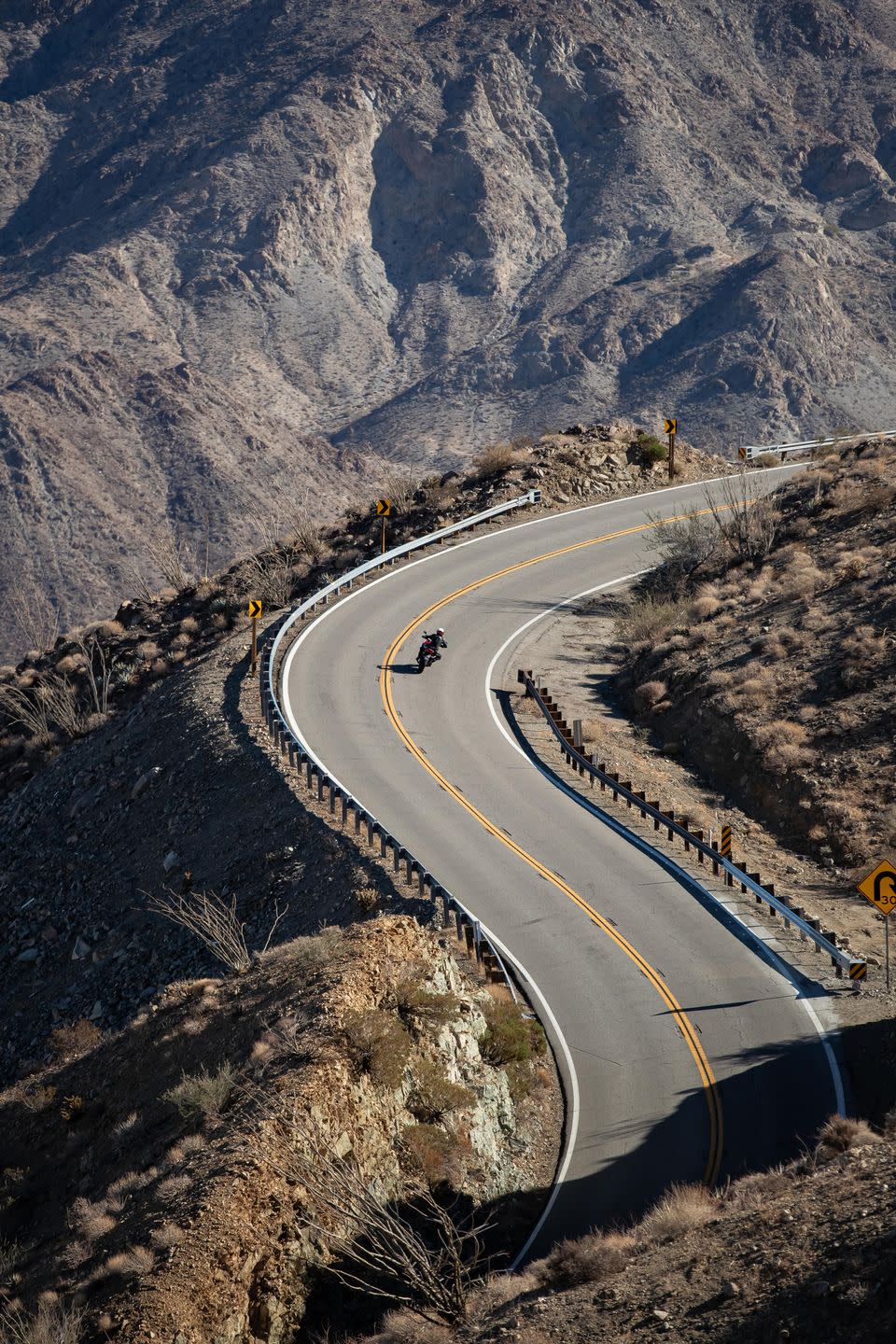The Ducati Multistrada V4 Pikes Peak Does It All

The 2022 Ducati Multistrada V4 Pikes Peak, named for the Pikes Peak International Hill Climb race that Ducati has won no less than seven times since the Italian manufacturer’s 2008 debut, aims to elevate the performance of Bologna’s do-it-all machine to new heights. The self-proclaimed “Sportiest Multistrada Ever” uses a combination of comfortable ergonomics, a capable chassis, mountainous power, and incredibly clever electronics in order to provide a riding experience that can range from leisurely, to immensely thrilling, to even a bit frightening.
The upright, neutral riding position convinces me that the ride will be comfortable. A twist of the keyless, black ignition knob brings the cockpit’s 6.5 inch TFT color display to life. The high resolution display allows riders to configure everything from the engine’s power level, to the stiffness and damping levels of the electronic Öhlins suspension, to the following distance held by the motorcycle while it’s radar-informed Adaptive Cruise Control system is active. There are also four ride modes: “Urban”, “Touring”, “Sport”, and of course, “Race,” each able to be customized to suit an individual rider’s preferences. Seeking a softer, more forgiving suspension setup when in Touring mode? Or maybe a bit more liberty when lifting the front wheel off the ground in Sport mode before DWC (Ducati Wheelie Control) tapers power and torque in order to maximize acceleration while preventing over-rotation? These settings, along with varying levels of DTC (Ducati Traction Control) and Cornering ABS can be adjusted and saved within each mode.

I spent relatively little time in “Urban” and “Touring” ride modes, and even less in “Sport”. Not long after being led out of downtown Palm Springs and onto the test route, we were in Race Mode territory. Switching ride modes on-the-fly is relatively simple. A few intuitive movements with the left thumb on what Ducati calls a “joystick” and the display will prompt you to release the throttle/brakes in order to confirm your ride mode selection.
In Race Mode, everything about the motorcycle is turned up. Cracking the throttle elicits a direct and immediate response from the V4. From 2,500 to 6,000 RPM, a smooth swell of torque builds into a towering wave of power. The titanium-carbon, multi-chambered Akrapovic exhaust system (standard on the Pikes Peak model) makes the sound *that* much more enjoyable, both for the rider and for anyone within earshot. Beyond roughly 6,000 RPM the Multistrada’s second personality, veiled at lower speeds, erupts to the forefront. Growling turns to howling, with the torque curve plateauing around 8,500 RPM and horsepower continuing to steadily climb all the way to 10,500 RPM. Each upward click of the shift lever brings instantaneous and clutchless engagement of the next gear, thanks to a new quickshifter. Auto-blipped/rev-matched downshifts are as easy as pressing down on the shift lever.

This 170 horsepower motorcycle (which, according to my butt-dyno, could very well be an understatement) is rather effective at shrinking the distance of a straightaway. Fortunately, the Multistrada’s braking system is borrowed directly from it’s terrifyingly fast cousin, the Panigale V4. Dual front 330mm discs paired with Brembo Stylema monobloc calipers, and a single rear 265mm disc with a floating Brembo caliper provides unbelievable stopping power. Such a powerful braking system can only be made full use of with the help of sticky tires and an effective ABS system. Even when pushing braking zones deeper into the corner than one should, or when emergency braking in the middle of a turn, Ducati’s “Cornering ABS” has your back. After rounding the apex, feel free to basically grab as much throttle as you want. A combination of lean-sensitive traction control and super-sticky, super wide Pirelli Diablo Rosso IV tires–wrapped around some pretty sweet looking forged/lightweight Marchesini wheels–puts down the power in a way that makes you wonder, “How?”
The Pikes Peak’s new Öhlins Smart EC 2.0 suspension is “event based,” meaning it senses and automatically adjusts based on rider input. Grabbing a handful of throttle in second gear? It knows what to do. Braking hard, suddenly? Likewise. You know something is working well when you don’t even think about wanting to adjust it.

The cleverness of the Pikes Peak benefits the rider in more than just sport riding or emergency braking situations. Ducati’s Adaptive Cruise Control system utilizes radar technology at its nose and tail to inform the motorcycle of its surroundings. Specify one of several following distance options and set a desired MPH - the motorcycle will maintain speed, accelerate and brake all on its own in order to maintain that predetermined gap between you and the car or rider(s) in front of you.
On a relatively twisty mountain road, with our group of riders wavering in speed from about 40 to 60mph, I set the ACC to a following distance of “Near” and a speed of 65mph. Allowing a motorcycle to take control of accelerating and braking is a major exercise in trust, but the Multistrada performed pretty much exactly as advertised. The bike held distance through every change in speed and even heavy braking, completely on its own, when the riders in front of me slowed rapidly on entry to a right hand hairpin. My only real complaints? It can be a tad slow to begin accelerating after the vehicle in front of you begins to pull away and I did experience a moment where the bike seemed confused; it continued braking through the middle of a turn after the riders in front of me had already begun pulling away onto the next straight. Aside from this incident, the ACC performed impressively. The rear radar is also used to inform a Blind Spot Detection system, which illuminates a yellow light on each side mirror when a vehicle is occupying your blind spot. Initiating a turn into that occupied area will cause the yellow light to flash. It’s a simple feature that helps mitigate risk.

Enthusiasts rarely seek out a machine with “more” rider/driver aids. Historically, these aids detract from the thrill and experience of a vehicle in order to make it “safer”. This has led to a stigmatization of any sort of electronic intervention. The Ducati Multistrada V4 Pikes Peak is a rare exception. The various rider aids actually make the motorcycle more thrilling, enabling the rider to go faster, easier. Think of it this way: For the bottom 98ish percent of riders, the Pikes Peak’s electronics make the astounding performance capability of this machine accessible, enjoyable, and relatively safe. For the top 2ish percent of riders, the electronics make for a road-going, touring-capable “race bike” that can be comfortably and predictably ridden at its absolute limit.
When it comes to touring, I honestly can’t think of another “new” motorcycle that I’d rather ride across the country on. The Pikes Peak is comfortable, has all the cool tech, and can absolutely destroy any twisty stretch of road you come across. Oh and the 36,000 mile interval for valvetrain inspection/service is a huge selling point for this bike, if you plan to do serious miles on it. My biggest complaints? Visually speaking, it’s tail is a bit dominated by the large fender/license plate mount and passenger handles. I also accidentally beeped the horn about 10 times during one day of riding, though that one might be a “me” problem. But if you intend on dropping around $30K (and be honest, probably more) on an absolute weapon of a sport bike that offers serious touring capability - the Pikes Peak is a brilliant choice.

You Might Also Like

 Yahoo Movies
Yahoo Movies 
